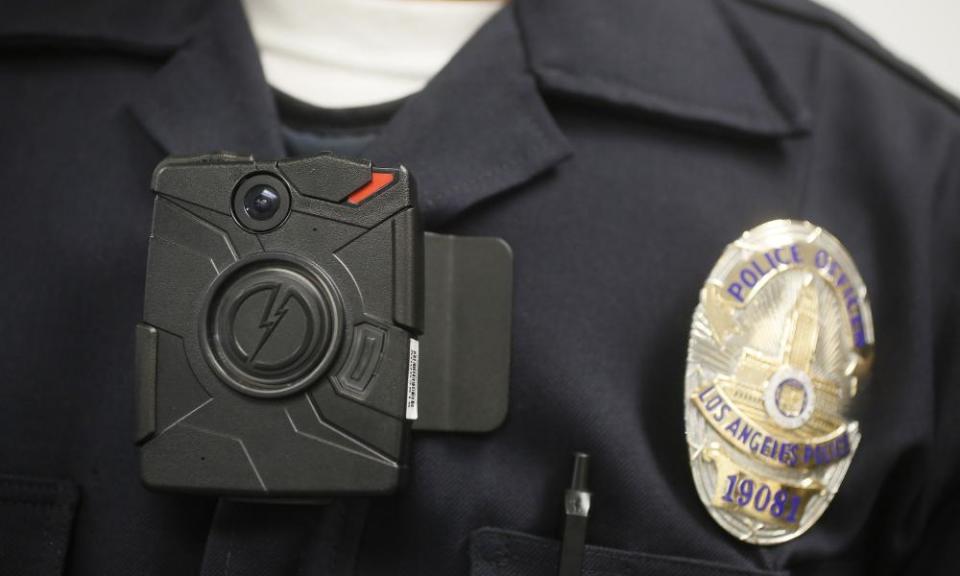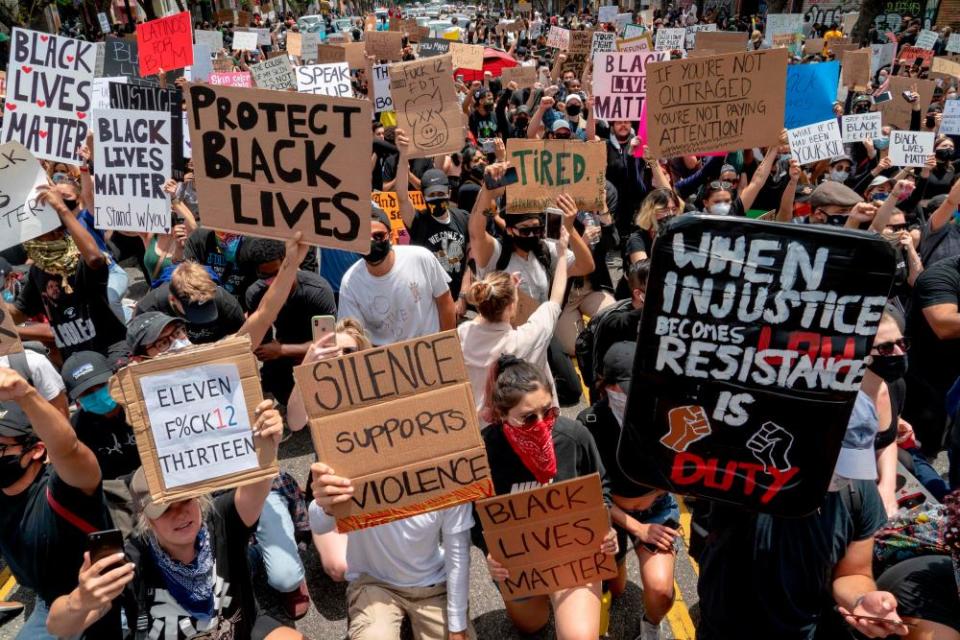Body cams help hold police accountable. In LA, it can take a lawsuit to get footage

Body-worn camera footage can be crucial in cases where police are accused of using excessive force – it helped a Minnesota jury understand the full details surrounding George Floyd’s death, and also shed light on the police killings of 13-year old Adam Toledo in Illinois and 16-year old Ma’khia Bryant in Ohio this spring.
In Los Angeles, advocates and attorneys say that despite the existence of a large scale body-worn camera program, it remains incredibly difficult to obtain police body-cam footage in the vast majority of cases and that even for police interventions that lead to serious injuries, it takes time, and effort to get access to all relevant images.
The Los Angeles police department (LAPD) is facing at least three lawsuits that hinge on police wrongdoing revealed in body-worn camera footage.
Like many American police departments, the LAPD adopted the widespread use of body cameras under pressure from activists protesting the police killings of multiple unarmed Black people across the country. When police in Ferguson, Missouri, shot and killed Michael Brown, 18, his family had called upon police departments to adopt BWCs (body-worn cameras) to document police behavior. Brown’s death was not caught on camera.
US police departments had started using the technology about a decade before. The police department of American Fork, Utah, in 2007 became the first recorded in the Atlas of Surveillance to use BWCs. Small police departments in the UK had piloted the cameras as early as 2006, largely as an investigative tool. In the US, too, early reporting on BWCs focused on their potential as an investigative tool rather than their potential to monitor police behavior.
The business of the police should by default be in public
John Burton, attorney
Even though activists and politicians had pushed for BWCs as a police accountability tool, the LAPD at first forbade the public release of the footage, citing concerns about privacy and compromising investigations. The department changed course, however, in 2018 with a “critical incident policy” that mandated the release within 45 days of footage of encounters including police shootings and cases where police force caused people to suffer great bodily injury or die. Anyone can access this footage on the LAPD’s Disclosable Documents page.
The critical incident policy is among the most transparent in the US – some police departments have no release policy at all – and California instituted a similar rule for the entire state the following year. But in practice, accessing the footage remains difficult, according to advocates and attorneys.
California police are allowed to withhold footage even in critical cases, if they can demonstrate that the release would interfere with an ongoing investigation, or violate privacy. Rarely does the department release all footage available.
“[California police departments] really do everything and go out of their way to make it difficult,” said Shaleen Shanbhag, an attorney representing Ben Montemayor, who filed a federal lawsuit against the LAPD alleging excessive use of force during a Black Lives Matter protest.
“Typically, we ask for the video. And first, they’ll refuse because there’s an ongoing investigation into the incident,” said Shanbhag. Then, she said, the police department may give a legal team access to some footage, but won’t provide all of it or release it to the public. So attorneys continue to file requests, she said, and might end up going before a judge who can rule to order the footage released if the department continues to refuse the release.
Montemayor, Shanbhag’s client, was hit with “less lethal” projectiles fired by LAPD officers at a Black Lives Matter protest in Los Angeles last June. The ammunition ruptured one of his testicles into multiple pieces.
Montemayor’s case is one of many calling into question the LAPD’s use of violence during BLM protests last summer. BWC footage released by the LAPD last September shows Montemayor holding a sign and quickly giving in to officers as they pull it away from him. Then, Montemayor suddenly crumples forward and screams in pain. A freeze frame shows a projectile hitting his genital area.
Shanbhag described the footage as “a little one minute snippet”. It is chaotic and Montemayor is obscured for much of it, she said. The legal team is now working to get access to footage from other officers who were involved, and who approached Montemayor from other angles.
Montemayor remembers feeling “unbelievable pain and confusion” during the incident. In his suit, he said he in no way resisted the officers, and does not remember hearing a dispersal order.
Without the footage, Shanbhag said, “it’s hard to tell what happened”.

Monique Alarcon, another attorney in Los Angeles, said that in addition to withholding some footage, the LAPD sometimes edits their releases in a way that can be misleading.
Alarcon’s client, CJ Montano, alleges that he was hospitalized with head injuries after an LAPD officer shot him in the head with a projectile as he was holding his hands up and backing away during a BLM protest last summer.
Video of the incident released by the LAPD includes a heavily produced introduction and a recorded phone call of officers requesting backup and saying protesters were throwing rocks and bottles at officers.
Alarcon, however, says she has seen additional footage of the incident under a protective order, meaning that this footage is not publicly available, and that none of that footage shows protesters throwing rocks and bottles at the time of Montano’s shooting.
In Montano and Montemayor’s cases, the LAPD was forced to release the initial footage under the critical incident mandate. Antone Austin’s 2019 interaction with police did not fall under that category, and in addition to suing the LAPD for racial profiling, wrongful arrest and excessive use of force, his legal team had two options to access footage of his arrest: a public records request or a lawsuit.
Public records requests for BWC footage are routinely denied, according to a search of the LAPD’s public records website. Lawsuits require time and money.
After Austin filed his suit last year, his legal team also fought to have the images of his arrest released. The footage the LAPD was forced to release in April showed that Austin had calmly greeted officers before he was told to turn around and was forcefully detained. Police arrested Austin, who is Black, while searching for a white suspect.
The release of the video sparked controversy on social media, where many argued Austin was racially profiled.
Related: ‘We’re terrorized’: LA sheriffs frequently harass families of people they kill, says report
Alarcon, the lawyer in the Montano case, said she had spent as many as six months working pro bono to get access to BWC footage in some criminal defense cases.
John Burton, an attorney who specializes in civil rights litigation in California, said that the lack of transparency when it comes to BWC footage is “outrageous”. Burton said that because getting footage released to the public is such a hassle, lawyers agree to accept a protective order – which only allows legal teams to see the footage.
“The business of the police should by default be in public,” he said. “We don’t have secret police, we don’t have death squads.”
An LAPD spokesperson said the department cannot comment on cases undergoing pending litigation or on related policies.
As police departments across the US reckon with cases of excessive force, BWC policy is evolving. Several states have legislation pending that would require greater transparency with BWC footage. And as police shootings and deaths continue to occur, public calls for access to footage grow ever louder. Protesters in Knoxville, Tennessee, are now pushing for BWC footage of police shooting and killing a high school student to be released.
Despite the legal battles, increased transparency in California has made attorneys’ jobs easier, Shanbhag said.
“I’m really glad that BWC footage is becoming so widely used,” she said. “I think without it, a lot of folks wouldn’t see how out of control these police officers are. When they take their oath they are sworn to serve and protect. And some of these videos show that what they’re doing is torturing and abusing people. It’s changing the narrative.”

 Yahoo Finance
Yahoo Finance 